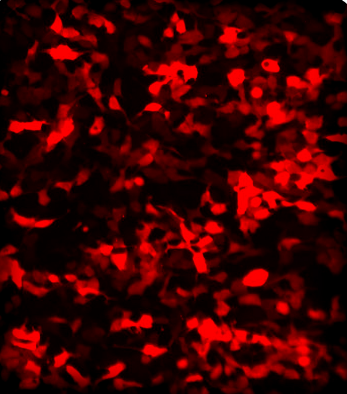Reporter Cell Lines
Do you have trouble tracking the engrafted cells in vivo? Do you want to monitor gene expression or protein trafficking dynamically? If the answer is yes, the reporter cell line will be an ideal tool for you.
Benefited from the discovery of reporter genes/proteins (e.g., green fluorescent protein (GFP), luciferase), cell lines are engineered to integrate reporter expression cassettes into its genomes. With the ‘visible’ tag, these reporter cell lines are valuable tools for various scientific studies,such as analysis of gene expression and regulation, cell labeling and in vivo imaging, tumor evaluation, and drug screening.
With robust virus production technology as well as years of experience, scientists at Alstem have established a growing library of reporter cell lines to meet your experimental demand. Our current collections include but not limit to luciferase/GFP, luciferase/tdTomato, nanoluciferase/tdTomato dual reporters cell lines. The type of donor cell covers HEK293, HeLa, Jurkat, A375, HCT116, MC38, etc.

Highlights:ALSTEM offers Cre Recombinase Reporter HEK293 Cell Line (CRE01). This cell line is generated from HEK293 cells by transducing a lentivirus that carries a human DNA fragment in which two loxP sites in the same direction are included. When Cre recombinase is present, the genomic DNA flanked by loxP sites is deleted, resulting in a larger DNA fragment amplified by PCR than the wild-type DNA.
Description:The Cre/LoxP recombination system is a versatile and powerful tool for DNA manipulations such as deletions, insertions, translocations, and inversions at specific sites in the DNA of cells. The system uses Cre recombinase to recombines a pair of Lox sites. Depending on the direction and distance of the LoxP sites, DNA flanked by the LoxP sites can be deleted, inversed, or translocated.
Cre Recombinase Reporter HEK293 Cell Line was derived from HEK293 cells by transducing a lentivirus that carries a human genomic DNA fragment that contains an insertion with two loxP sites in the same direction (Figure 1A). This cell line will be very useful as a sensitive reporter for detecting Cre recombinase activity. When cells were transfected with a Cre expression plasmid (pLenti-EF1-Cre-GFP-PGK-PURO, Cat. Number: CRE02), the insertion was deleted in the stable cell line, but not in non-transgenic cells or wild type cells (Figure 1 B-C, Figure 2).

Figure 1. Cre Reporter Stable Cell Line Panel A) Before addition of Cre recombinase. The stable cell line carries the transgene that contains a human genomic DNA with an insertion flanked by loxP sites. Panel B). After addition of the Cre recombinase, the insertion is deleted. This event is detected by PCA amplification of a 206 bp fragment. Panel C) The Same PCR amplifies a shorter (172 bp) fragment in the non-transgenic and wild type DNA.


Figure 2. Cre activity detection in Cre reporter cell line. Panel A) GFP fluorescence. HEK293 cells were transfected with a Cre-GFP plasmid at 80% cell confluency and express Cre-GFP as green signals. Panel B) PCR results. Cre reporter cell line shows efficient DNA deletion as revealed by a larger PCR fragment that contains a loxP site in addition to the human genomic DNA. Positive control template: Cre reporter plasmid. Expected bands: DNA removal = 206 bp, Wild type DNA = 172 bp.
Specifications:
| Product Name | Cre reporter HEK293 Cell Line |
|---|---|
| Shipping Condition | Dry Ice - Overnight Shipping |
| Storage and Stability | Store in vapor phase of liquid nitrogen immediately upon receipt. This product is stable for 6 months when stored as directed |
| Quality Control | Each vial contains approximately 1x10^6 cells with >95% viability before freezing. Each lot of cells are tested for Cre activity, growth, and viability following recovery from cryopreservation, and free of mycoplasma and competent lentivirus as well. |
| Restricted Use | For Research Use Only. Not for use in diagnostic or therapeutic procedures. |

